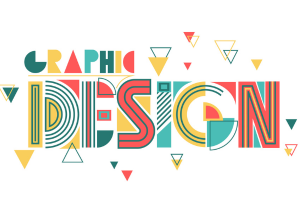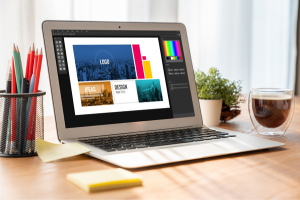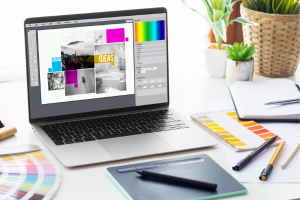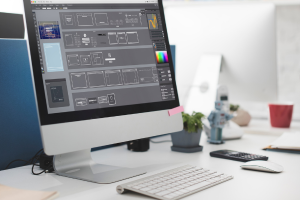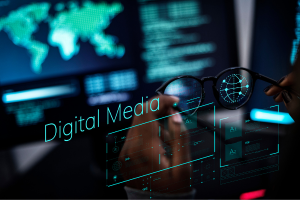The journey of starting up is exciting, but the competition is tough. One of the first branding decisions that matter most is logo design. Because a professional logo design should do more than just look good – it builds trust, shapes perception, and sets the baseline of your brand identity.
This guide provides an overview of everything you need to know about professional logo design for startup applications, including why it matters, what makes up a great logo, and how to develop one that leads to long-term growth.
Why Professional Logo Design Matters for Startups
Today’s fast-paced, visual world makes your logo very often the first notice for potential customers. For start-ups, this first phase could prove to be a crucial, make-or-break moment. Here are some reasons why having a professional logo design is an intelligent investment:
1. Builds Instant Trust and Credibility
Professionally made logos validate legitimacy. They show how serious the venture is and make it easier to communicate with investors, clients, and customers.
2. Creates a Strong Brand Identity
Your logo is the anchor, the visual representation of the brand. When designed strategically and intentionally, they communicate values, vision, and positioning at a glance.
3. Enhances Brand Recognition
Memorable logos like Nike, Apple, or Airbnb are powerful because they are easily recognized. A well-designed logo increases the brand recall, which is extremely important in crowded markets.
4. Supports Marketing and Communication
From business cards to websites, packaging, and social media, it is everywhere. A professional design ensures consistency across platforms, hence emphasizing message and personality of the brand.
Elements of a Successful Startup Logo
What separates the amateur logo from a professional one? Here are some of the basic features that must be possessed by every start-up logo:
1. Simplicity
An uncomplicated logo is easy to familiarize oneself with the brand, remains in memory, and is recreated. Riddance to clutter, too many colors, or illustration complexity. Simplicity is the rule of thumb when it comes to logo design.
2. Relevance
This logo defines the business, its industry, and its audience. A technology startup could even have logos with clean and precise lines with modern fonts, as opposed to a culture agency that would prefer brighter and playful visuals.
3. Scalable
These professional logos can be drawn in vector form, so they may be scaled up to any size without any loss in quality-from a favicon to a billboard.
4. Versatility
Even in black and white, your logo must dependably shine under light and dark shades and show itself in its various formats (horizontal, stacked, icon-only, etc.).
5. Timelessness
In reality, you want your logo to avoid trends that may quickly become outdated. An ageless logo does not require a fresh redesign yearly and continues to serve well.
Types of Logos and What’s Best for Startups
There are a few logo style categorizations, as you can see. Knowing the styles will be of much help if you are going to find the best fit among all those for the identity of your startup.:
1. Wordmark (Logotype)
It refers to presenting the name of a company in stylized but wonderful font (e.g., Google, Coca-Cola). It is great for new startups that want to increase the recognition of their names.
2. Lettermark (Monogram)
Initials or abbreviations are used in the examples: IBM, HP. Ideal for a company whose name or title is long or complicated.
3. Pictorial Mark (Symbol or Icon)
A form of a recognizable image or icon (e.g., Apple, Twitter). The ideal solution when you want a strong visual representation.
4. Abstract Mark
Uses geometric or abstract forms (e.g., Nike swoosh). Flexible and often unique to your brand.
5. Combination Mark
This is made up of text and a symbol (e.g., Adidas, Dropbox). Highly versatile and hence recommended for most startups.
6. Emblem
Text inside a symbol, or badge, example: Starbucks, Harley-Davidson. Strong and traditional: less flexible for digital applications.
The Professional Logo Design Process for Startups
Here is how a typical professional logo design goes:
1. Discovery and Research.
A designer initiates discovering your startup’s mission, audience, competitors, and visual preferences. Gathering insights.
2. Brainstorming and Concept Development
Based on your brand strategy, multiple logo concepts are sketched and explored. Designers will test different styles, shapes, and layouts that seem best aligned with your brand personality.
3. Digital Drafting and Refinement
Render digitally the best concepts using an artwork vector design software, like Adobe Illustrator. Time for colors, typography, and spacing refinement for a polished appearance.
4. Presentation and Critique
The designers will present the logo options with mock-ups for understanding how each would appear in different media. Allow for feedback, and this will be done in the revision process.
5. Finalizing Deliverables
When finally approved, expect getting your logo in several file formats: AI, SVG, PNG, JPG, PDF, along with a style guide. Here are some of the common pitfalls regarding logo design that startups sometimes encounter.
Common Mistakes Startups Make in Logo Design
DIY with No Design Experience
Using tools like Canva might be tempting, but generic designs just would not give a single second for that potential part of your brand to stand out. Cut corners early; later could come back to haunt you when it comes to the long-term investment of a logo.
Just Following Trends
Like most trendy things, those designs look old; one or two years most. Count on having longevity rather than novelty.
Copying Other Competitors
You want to stand apart, not in. A copied logo is an invitation for legal issues and dilutes one’s brand.
Ignoring Brand Strategy
Your logo should reflect the voice and values of your brand. Design is not strategic thinking, merely inconsistent.
Tips for Working with a Logo Designer
Provide a Detailed Brief
Your brand values, mission, target audience, competitors, and design preferences should all be included.
Be Open to Ideas
Critically review your designer’s every idea while trusting him/her.
Request a Brand Style Guide
Logo Usage Guidelines: Ask for fonts, color, and spacing guidelines so that the logo is used consistently.
Think Long-Term
Don’t go for just a today-cool logo; let it grow with your start-up.
Real-World Examples of Great Startup Logos
Dropbox
It is simple, clean, and modern. It symbolizes a box (storage), but with a flexible shape.
Slack
Colorful yet playful, yet well structured- It’s about collaborative communication.
Mailchimp
A fun mascot (A Chimp) combined with vigorous typography makes it recognizable.
These were the start-ups that took logo designing seriously since their early days-and were rewarded for the same in brand equity.
Conclusion
More than just a visual, your startup’s logo is your identity, first impression, and face of business. It stands to reason that you would want to use a professional logo design that ensures your brand conveys clarity, confidence, and credibility from the very first moment.
Don’t take shortcuts; instead, evolve a systematic design process that informs the construction of your logo to generate interest and hold lifetime loyalty and trust. No time can ever be riper for startups wanting to demonstrate the effectiveness of their brand presence than now.


